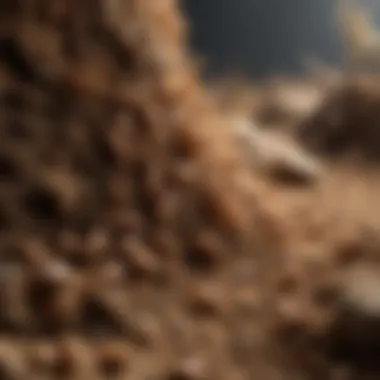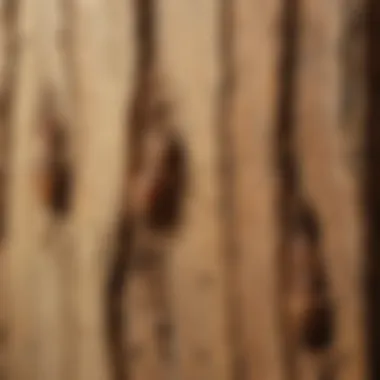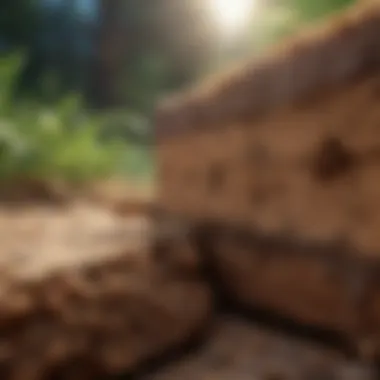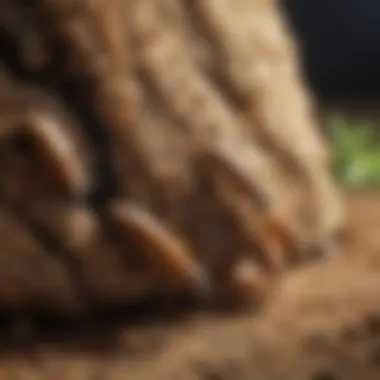Effective Strategies for Treating Subterranean Termites


Intro
Subterranean termites pose a significant threat to structures, crops, and overall agricultural productivity. Understanding how to effectively manage these pests is essential for farmers and homeowners alike. This guide dives into comprehensive strategies to treat subterranean termites, discussing methods for identification, prevention, treatment, and ongoing management.
Topic Overview
Definition and Importance
Subterranean termites are wood-destroying insects that live underground and thrive in moist conditions. They cause extensive damage to wooden structures, crops, and trees. Their presence can lead to financial losses and compromise the integrity of buildings, making their management crucial.
Brief History and Evolution
Key Techniques and Innovations
Sustainable Farming Practices
Sustainable approaches to pest control can significantly reduce the impact of subterranean termites. These practices may include:
- Crop rotation to disrupt pest life cycles.
- Diverse planting strategies to minimize infestations.
- Implementing beneficial organisms that prey on termites.
Advanced Agronomic Technologies
Emerging technologies have shaped how farmers approach termite management. Some notable innovations include:
- Baiting systems that target nests and limit colony growth.
- Soil treatments that create barriers against subterranean termites.
- Use of monitoring devices for early detection and assessment of termite activity.
Practical Applications
Step-by-Step Guides
To effectively treat subterranean termites, consider the following steps:
- Inspection and Detection: Look for signs of termites, such as mud tubes and damaged wood.
- Assessment: Identify the degree of infestation.
- Choose a Treatment Method: Select between chemical treatments, baiting systems, or natural alternatives.
- Implementation: Apply the chosen method according to guidelines.
- Follow-up Monitoring: Regularly inspect the area to prevent re-infestation.
Case Studies or Real-World Examples
One notable example of effective subterranean termite management occurred on a large farm in California. By employing a combination of baiting systems and regular inspections, the farmers significantly reduced termite populations, thus preserving their crops and structures. This success emphasizes the importance of an integrated approach to pest management.
"Effective pest control is about understanding and managing the entire ecosystem, not just treating symptoms." - Pest Management Expert
By applying comprehensive strategies tailored to the unique challenges posed by subterranean termites, individuals and farmers can protect their properties and resources effectively.
Understanding Subterranean Termites
Understanding subterranean termites is fundamental for effective management and treatment against these destructive pests. This article breaks down various aspects of their characteristics, habitats, and lifecycle to arm readers with knowledge that aids in early detection and strategic prevention. The significance of this study is evident: by comprehending the biology and behavior of subterranean termites, individuals can implement more effective control measures, reducing the potential for significant damage to homes, crops, and other structures.
General Characteristics
Subterranean termites are unique creatures, identifiable by specific traits. They are generally small, ranging from about a quarter to half an inch in length. Their color varies, but they typically appear in shades of cream to light brown. This coloration makes them less conspicuous, allowing them to blend seamlessly into their environment.
Another notable feature of subterranean termites is their social structure. They exist in large colonies with a clear hierarchy, typically led by a king and queen. The worker termites are responsible for foraging and caring for the young, while soldiers defend the colony from threats. This structure plays a crucial role in their survival and reproduction.
Moreover, subterranean termites possess a remarkable ability to communicate through pheromones, which helps maintain colony organization and alert members to dangers. Understanding these characteristics aids in identifying control methods that target their social behaviors.
Habitats and Behavior
Subterranean termites thrive in moist environments, which is key to their survival. They often establish their colonies below ground, where they can access moisture from the soil. However, they need to venture above ground to find food sources, which commonly include wood, paper, and other cellulose-based materials. Their preference for wood means that homes and agricultural structures are prime targets.
These termites construct mud tubes to travel between their food sources and nest. Understanding this behavior is vital for pinpointing infestations. When inspecting properties, look for these tubes against foundation walls or in crawl spaces. Also, their tendency to seek out damp places highlights the importance of moisture control in prevention strategies.


Lifecycle of Subterranean Termites
The lifecycle of subterranean termites consists of several stages: egg, nymph, and adult. This phased development has significant implications for infestation management. The queen can lay thousands of eggs, ensuring rapid colony expansion. During the nymph stage, young termites undergo several molts before reaching adulthood.
Adult termites can then assume different roles, contributing to the colony's survival and proliferation. This rapid lifecycle means that once termites establish an infestation, they can cause extensive damage in a short period. Recognizing the stages of their growth is crucial for implementing targeted treatment strategies.
Understanding the lifecycle and social structure of subterranean termites allows for more effective control measures and enhances overall pest management efforts.
Identifying Termite Infestation
Identifying termite infestation is a critical step in managing subterranean termites effectively. Early detection of these pests can save homeowners and farmers substantial costs associated with repairs and pest removal. Understanding the signs and employing effective inspection methods helps in recognizing the presence of these destructive insects.
Signs of Infestation
Subterranean termites can cause extensive damage before they become visible. Here are some key signs to watch for:
- Mud Tubes: These are tunnels made from soil and feces, allowing termites to travel between their colony and food sources. You may find these tubes on walls, foundations, or inside crawl spaces.
- Wood Damage: Termites eat wood from the inside out, leaving a thin shell. If you find hollowed or damaged wood in structures, it might indicate an infestation.
- Swarmers and Wings: During their mating season, mature termites, known as swarmers, will leave their colony in search of new nests. If you see discarded wings near windows or light sources, it is a sign they are nearby.
- Frass: This is termite waste, often resembling sawdust. Discovering frass can indicate active termite presence.
Regularly checking for these signs is essential. Not all indications are evident immediately; some might develop over time, emphasizing the need for vigilance.
Inspection Techniques
Conducting a detailed inspection can help confirm suspicions of termite activity. Here are some techniques:
- Visual Inspection: Start by examining the exterior and interior of structures, focusing on areas like foundations and wood.
- Probing: Use a flathead screwdriver to probe wood for hollow spots. Be cautious, as this may cause some damage to the structure but can help identify infestations.
- Moisture Measurement: Termites thrive in damp environments. Utilizing a moisture meter can help detect potentially attractive areas for termites.
- Infrared Cameras: These can identify temperature differences in walls, which may signal termite activity. It is more advanced and can give precise information about hidden infestations.
- Bait Stations: Setting up bait stations outside the structure can help determine the presence of subterranean termites. If termites feed on the bait, it confirms their activity nearby.
Remember: While identifying termite infestation is vital, it is often useful to consult with pest control professionals for thorough inspections.
In summary, recognizing the signs of infestation and employing effective inspection techniques arms you with the knowledge necessary to act promptly against subterranean termites. By combining vigilance with proper tools and methods, you can protect your property and mitigate potential damage.
Prevention Strategies
Addressing subterranean termite infestations starts long before any treatment is considered. Prevention is crucial because even minimal exposure can turn into a significant problem. Effective prevention strategies not only ensure the integrity of structures but also save homeowners from potential financial burdens associated with extensive damage. Leading with moisture control, sealing entry points, and landscaping considerations are key elements in a holistic strategy against these pests.
Moisture Control
Moisture is a fundamental factor that attracts subterranean termites. Maintaining low moisture levels around a property significantly reduces the likelihood of infestation. Regularly inspect for leaks in plumbing and roofing; this includes gutters and downspouts. Ensure proper drainage away from the foundations. Employing dehumidifiers in basements can also help control humidity levels.
Furthermore, here are some specific measures to consider:
- Use graded soil: Sloping soil away from the foundation helps direct water flow away.
- Manage landscaping: Keep plants and vegetation well-trimmed to promote airflow.
- Inspect crawl spaces: Regular checks can prevent moisture accumulation.
Sealing Entry Points
Another critical aspect is sealing potential entry points. Subterranean termites are adept at finding ways into homes, mainly through small cracks and crevices. A thorough assessment of the foundation is necessary. Areas around utility pipes, vents, and foundations should be scrutinized closely.
Some actionable steps include:
- Fill gaps with caulk, especially around windows and doors.
- Install metal flashing to protect vulnerable areas.
- Regularly check and replace deteriorating wood and siding.
These preventative actions create a physical barrier that significantly hinders termite access.
Landscaping Considerations
Landscaping plays an essential part in termite prevention. The design and maintenance of a property can deter these pests. For instance, avoid using untreated wood mulch near the foundation as it serves as a food source.
Important landscaping practices include:
- Keep wood piles at least 20 feet away from the structure.
- Plant trees and shrubs away from the foundation to promote air circulation.
- Use concrete, stone, or metal barriers as decorative mulch instead of wood.


In summary, taking proactive measures in moisture control, sealing entry points, and mindful landscaping significantly reduces the risk of termite infestation. Proper care and consistent monitoring create a strong defense against subterranean termites.
Treatment Options
Choosing the right treatment options is crucial for successfully managing subterranean termite infestations. These pests are particularly difficult to control due to their hidden activity below ground and within structures. Understanding the various treatment methodologies not only enhances efficacy but also minimizes potential harm to the surrounding environment. This section will delve into three primary treatment options: chemical treatments, baiting systems, and physical barriers.
Chemical Treatments
Chemical treatments are often the first line of defense against subterranean termites. These treatments typically involve the use of termiticides, which are designed to eliminate termites and create a barrier to prevent future infestations. The choice of chemical must factor in both effectiveness and safety.
- Types of termiticides:
There are two main types: liquid and baiting formulations. Liquid termiticides are applied in trenches around structures, creating a chemical barrier. Baits, on the other hand, are installed in strategic locations to attract and eliminate termites systematically. - Application Methods:
Proper application is vital. Professionals often use a trenching method, ensuring that the chemical reaches the necessary depth where termites are active. Misapplication can lead to ineffective treatments and subsequent infestations. - Regulations and Safety:
Compliance with local regulations is essential when using chemicals. Select products that are registered with relevant authorities, ensuring they meet safety standards for humans and beneficial insects alike.
Baiting Systems
Baiting systems are another effective method for managing subterranean termites. These systems involve placing bait stations in the ground that contain slow-acting insecticides, which termites consume and transport back to their colonies.
- Operation Mechanism:
The allure of wood and cellulose-based bait attracts the termites. Once ingested, the toxic substances affect the entire colony over time, minimizing the risk of reinfestation. - Advantages of Baits:
Using baiting systems reduces the amount of toxic chemicals introduced into the environment, making them more eco-friendly. They also provide continuous monitoring of termite activity, allowing for more precise intervention. - Effectiveness and Monitoring:
Baits require regular inspection and monitoring to ensure effectiveness. If termite activity is detected, the bait must be replenished to continue the treatment.
Physical Barriers
Physical barriers are a preventive strategy that can be used alongside chemical and bait treatments. These barriers physically block termites from entering a structure, providing a robust line of defense.
- Types of Barriers:
Common materials include steel mesh, sand, or basalt. Each material serves to create a robust physical impasse against subterranean termites. - Installation Considerations:
Installation should occur during the initial construction of a building or during extensive renovations. Ensuring a proper fit and coverage is important for preventing infestation. - Integration with Other Methods:
While physical barriers provide a strong defense, they are best used in conjunction with chemical or bait treatments for comprehensive termite management. This multi-faceted approach enhances overall efficacy.
Properly understanding and implementing these treatment options can greatly reduce the risks associated with subterranean termites.
In summary, treatment options play a pivotal role in managing subterranean termite threats. Each method—chemical treatments, baiting systems, and physical barriers—offers distinct benefits and considerations. Recognizing and utilizing the right combination of these strategies can lead to effective prevention and management of future infestations.
Professional Termite Control Services
When dealing with subterranean termites, enlisting professional termite control services is crucial. These pests can cause significant damage to structures if not managed promptly and effectively. Professionals bring expertise that combines their knowledge of termite behavior with advanced treatment technologies.
Engaging a pest control expert ensures that the infestation is accurately identified and that the best approach for eradication is implemented. Homeowners may not possess the extensive knowledge required to effectively address these issues. A trained expert can spot subtler signs of infestations and recommend appropriate solutions.
Selecting a Pest Control Expert
When selecting a termite control expert, it is essential to consider several factors. First, verify the professional’s credentials. A licensed technician holds the necessary training and is compliant with local regulations. Next, inquire about their experience with subterranean termites specifically. Some pests require specialized knowledge due to their unique behavior and nesting habits.
Another critical component is reading reviews and testimonials. Feedback from previous customers can provide insights into the expert's reliability and effectiveness. The scope of services offered should also be evaluated. Seek professionals who provide comprehensive inspections, treatment options, and follow-up support.
It can also be helpful to ask potential candidates about their strategies. Understanding whether they use chemical or bait systems will help you select an expert whose methods align with your preferences.
Assessing Treatment Plans
Once a professional is chosen, analyzing the treatment plans they provide is important. A competent pest control service will tailor their approach based on the severity of the infestation and the specific needs of your property.
To assess a treatment plan, consider the following elements:
- Initial Inspection: A thorough examination should precede any treatment. The expert must identify all potential entry points and the extent of the infestation.
- Treatment Options: Evaluate the different methods proposed. Understand if they include chemical treatments, bait systems, or physical barriers, and their projected effectiveness.
- Duration and Monitoring: Ask how long the treatment will take and what kind of post-treatment monitoring will be conducted. Continuous evaluation is vital to ensure that the termites do not return.
- Guarantee Policy: A reliable pest control service often includes a guarantee. This indicates confidence in their solution and provides assurance for homeowners that additional measures will be taken if needed.
"Prevention is better than cure; this holds particularly true in termite management. Regular professional inspections can save homeowners from costly damage."
For more resources on pest control, you can visit Wikipedia, Britannica, and relevant forums on Reddit for community advice.
Ongoing Monitoring and Management
Ongoing monitoring and management of subterranean termites are crucial components of an effective termite control strategy. Once an infestation is identified and appropriate treatments are applied, it is essential to continuously keep track of the situation. This reduces the risk of re-infestation and ensures that the measures taken are effective. The benefits of continual monitoring are numerous, including early detection of new infestations and the ability to adjust prevention measures as needed. Homeowners must recognize that termite management is not a one-time event but a long-term commitment.
Regular Inspections


Regular inspections are a cornerstone of ongoing termite management. Termites can be stealthy and may remain undetected unless specific strategies are employed. Engaging a professional pest control specialist to conduct inspections regularly adds significant value. These experts usually check high-risk areas such as crawl spaces, basements, and around utility lines where moisture could accumulate. Homeowners should also perform periodic self-inspections. Here are some tips for effective inspections:
- Look for mud tubes: Termites build mud tubes that provide shelter and maintain humidity.
- Check wood for holes: Infested wood often has tiny holes or blistered surfaces.
- Inspect for discarded wings: Swarmers leave their wings behind during reproduction.
Being vigilant can help catch infestations early before extensive damage occurs.
Continual Preventive Measures
Adopting continual preventive measures is vital for managing termite risks. Even after treatments, it is essential to maintain strategies that deter termites from invading your property. Here are some effective preventive measures:
- Maintain proper drainage: Ensure that water drains away from the foundation of your home. Standing water can attract termites.
- Limit wood-to-soil contact: Store firewood and other wooden materials off the ground and away from buildings.
- Install physical barriers: Options like steel mesh or sand barriers can deter termite entry.
- Regularly assess landscaping: Trim any shrubs or trees that come too close to the house, as vegetation can provide an easy pathway for termites.
Effective monitoring and preventive measures create a formidable barrier against subterranean termites, drastically reducing the likelihood of an infestation.
By consistently inspecting and applying preventive strategies, homeowners can significantly increase their defenses against subterranean termites and prolong the life of their structures.
Legal and Environmental Considerations
Understanding the legal and environmental aspects of treating subterranean termites is crucial for several reasons. Regulatory compliance ensures that pest control methods meet local, state, and national guidelines, which often prioritize human safety and environmental protection. This article will not only address the laws and regulations governing termite treatment but also examine the ecological impact of various control methods. A proper grasp of these elements can help farmers and homeowners make informed decisions about managing termite issues.
Regulatory Compliance
Regulatory compliance in termite treatment involves adhering to laws that dictate how pest control can be conducted. Each region may have specific guidelines regarding the types of chemicals that can be used, how treatments should be applied, and requirements for certified applicators.
Some key considerations in regulatory compliance include:
- Licensing: Many regions require pest control businesses to be licensed. Homeowners should verify that any service used is compliant with these regulations.
- Chemical Use Restrictions: Certain pesticides may be banned or restricted due to their toxicity or potential environmental impact. Understanding which products are permissible can prevent legal penalties and harm to non-target species.
- Notification Requirements: In some areas, homeowners must notify neighbors and local authorities prior to applying treatment chemicals, particularly if those chemicals are potentially harmful.
Staying compliant can not only avoid legal issues but also ensures the safety of families and pets while minimizing harm to beneficial insects and the surrounding environment.
Impact on Ecosystems
When addressing subterranean termites, it is essential to consider the ecological ramifications of chosen treatment strategies. Chemicals used in pest control can persist in the environment, leading to a disruption of local ecosystems.
Key impacts of termite treatment on ecosystems include:
- Non-Target Species: Many treatment methods can inadvertently affect non-target organisms, including beneficial insects and other wildlife. Awareness of this can drive the selection of more eco-friendly options.
- Soil Health: Because subterranean termites contribute to soil aeration and organic matter decomposition, their eradication should be approached with caution to prevent imbalances in soil ecology.
- Biodiversity Loss: Utilizing aggressive chemical treatments can lead to declines in local biodiversity. It is essential to consider sustainable pest management practices that maintain ecological balance.
"A healthy environment is the foundation of sustainable agriculture. Effective termite management must align with ecological principles to preserve this balance."
Overall, incorporating legal and environmental considerations into termite management is vital for any effective strategy. This approach ensures compliance with regulations while promoting biodiversity and ecosystem health.
Resources for Further Learning
In the quest to efficiently manage subterranean termites, education remains pivotal. It is essential for homeowners and professionals alike to continuously expand their understanding of termite behavior and treatment methodologies. This section provides valuable resources that enhance knowledge and offer ongoing support in termite management. The importance of these resources cannot be overstated; they provide critical insights into evolving techniques and research findings.
Accessing varied learning materials aids in building a strong foundation. Books and publications offer in-depth analysis while online communities create avenues for real-time interaction and support. Together, they empower readers to tackle termite infestations effectively and confidently.
Books and Publications
Books and publications serve as primary resources. They give thorough explanations and guidelines regarding subterranean termites. Some notable recommendations include:
- "Termites: Nature and Control" by David P. Kibler explores the ecological and biological aspects of termites.
- "The Termite Control Handbook" by William H. Bate provides detailed procedures and strategies for effective control.
- "Preventing Termite Infestations" by Charles M. Flenner discusses preventative measures for infestation.
These texts dive into chapters covering termite biology, habitat preferences, and various treatment approaches. Readers gain a comprehensive view of both theoretical and practical aspects. Furthermore, they provide case studies, making it easier to relate theory to real-world scenarios.
Online Communities and Forums
Online communities and forums offer additional layers of learning. They facilitate discussions among those with practical experience in managing termite issues. Platforms such as Reddit and Facebook host groups dedicated to pest control. Participating in these spaces allows for:
- Sharing personal experiences
- Asking questions directly from experts
- Staying updated on the latest pest control strategies
For example, the subreddit r/pestcontrol features users who share strategies and results about different treatments. It’s a platform where anecdotal evidence can complement scientific literature, offering a well-rounded perspective on effectiveness and user satisfaction.
"The intersection of practical experience and scientific research is where effective termite management flourishes."
In summary, continuous learning through books and online platforms will equip individuals to deal with subterranean termites more effectively. Staying informed about the latest trends and methods is not just beneficial; it is essential for success in pest management.



